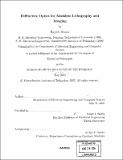| dc.contributor.advisor | Henry I. Smith. | en_US |
| dc.contributor.author | Menon, Rajesh, 1976- | en_US |
| dc.contributor.other | Massachusetts Institute of Technology. Dept. of Electrical Engineering and Computer Science. | en_US |
| dc.date.accessioned | 2005-06-02T19:25:53Z | |
| dc.date.available | 2005-06-02T19:25:53Z | |
| dc.date.copyright | 2003 | en_US |
| dc.date.issued | 2003 | en_US |
| dc.identifier.uri | http://hdl.handle.net/1721.1/17963 | |
| dc.description | Thesis (Ph. D.)--Massachusetts Institute of Technology, Dept. of Electrical Engineering and Computer Science, 2003. | en_US |
| dc.description | Includes bibliographical references (p. 229-233). | en_US |
| dc.description.abstract | Semiconductor industry has primarily been driven by the capability of lithography to pattern smaller and smaller features. However due to increasing mask costs and complexity, and increasing tool costs, the state-of-the-art technology in lithography is accessible only to a select few. Zone-plate array lithography (ZPAL) is a novel method of maskless lithography that aims to alleviate some of these issues while offering a solution that can be extended to the limits of nanolithography. In ZPAL, an array of diffractive lenses is used to form an array of spots on the substrate. Each spot is modulated independently by means of spatial-light modulators. This essentially creates a "parallel laserwriter". In addition, this lithography system can be converted into a parallel-confocal microscope, which enables fast, high-resolution imaging. This thesis addresses the performance of diffractive lenses, particularly high-numerical aperture zone plates for lithography and imaging using a combination of experimental and theoretical studies. A novel proximity-effect correction algorithm that was implemented effectively in a ZPAL system is also described. Variations to another diffractive lens known as the photon sieve are proposed. The first ever lithography results performed using these new elements are presented in this thesis. | en_US |
| dc.description.statementofresponsibility | by Rajesh Menon. | en_US |
| dc.format.extent | 233 p. | en_US |
| dc.format.extent | 12987132 bytes | |
| dc.format.extent | 13017569 bytes | |
| dc.format.mimetype | application/pdf | |
| dc.format.mimetype | application/pdf | |
| dc.language.iso | eng | en_US |
| dc.publisher | Massachusetts Institute of Technology | en_US |
| dc.rights | M.I.T. theses are protected by copyright. They may be viewed from this source for any purpose, but reproduction or distribution in any format is prohibited without written permission. See provided URL for inquiries about permission. | en_US |
| dc.rights.uri | http://dspace.mit.edu/handle/1721.1/7582 | |
| dc.subject | Electrical Engineering and Computer Science. | en_US |
| dc.title | Diffractive optics for maskless lithography and imaging | en_US |
| dc.type | Thesis | en_US |
| dc.description.degree | Ph.D. | en_US |
| dc.contributor.department | Massachusetts Institute of Technology. Department of Electrical Engineering and Computer Science | |
| dc.identifier.oclc | 57144200 | en_US |
